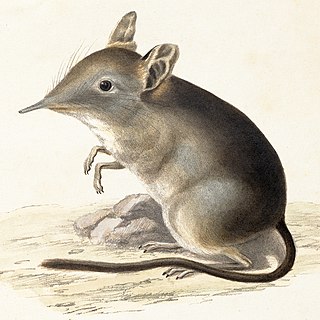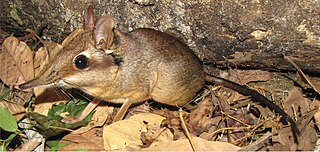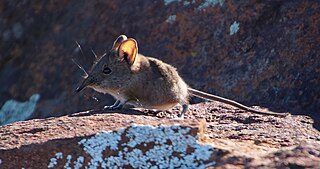
Elephant shrews, also called jumping shrews or sengis, are small insectivorous mammals native to Africa, belonging to the family Macroscelididae, in the order Macroscelidea. Their traditional common English name "elephant shrew" comes from a perceived resemblance between their long noses and the trunk of an elephant, and their superficial similarity with shrews in the order Eulipotyphla. However, phylogenetic analysis has revealed that elephant shrews are not properly classified with true shrews, but are in fact more closely related to elephants than to shrews. In 1997, the biologist Jonathan Kingdon proposed that they instead be called "sengis", a term derived from the Bantu languages of Africa, and in 1998, they were classified into the new clade Afrotheria.
Plasmodium brodeni is a parasite of the genus Plasmodium subgenus Vinckeia. As in all Plasmodium species, P. brodeni has both vertebrate and insect hosts. The vertebrate hosts for this parasite are mammals.

The short-snouted elephant shrew or short-snouted sengi is a species of elephant shrew in the family Macroscelididae. It is found over a wide area of Africa. Its natural habitats are dry savanna and subtropical or tropical dry lowland grassland.

The Cape elephant shrew, also known as the Cape rock elephant-shrew or Cape rock sengi, is a species of elephant shrew in the family Macroscelididae. It is endemic to South Africa, although it is a relatively common animal. Its natural habitat is rocky areas. Elephant shrews are not closely related to true shrews, nor to rodents such as mice. E. edwardii has been observed to be a non-flying mammal pollinator of the pagoda lily. Elephant shrews are floral pollinators due to their largely insectivorous diet. Elephant-shrews are pollinators of Hyobanche atropurpurea. It uses its long slender tongue to feed on the pagoda lily's nectar while getting the lily's pollen on its long nose. E. edwardii is also a pollinator of Protea sulphurea.

The dusky-footed elephant shrew or dusky-footed sengi is a species of elephant shrew in the family Macroscelididae. It is found in Democratic Republic of the Congo, South Sudan, and Uganda. Its natural habitat is subtropical or tropical dry lowland grassland.

The dusky elephant shrew or dusky sengi is a species of elephant shrew in the family Macroscelididae. It is found in Malawi, Mozambique, and Zambia. Its natural habitat is dry savanna.

The bushveld elephant shrew or bushveld sengi is a species of elephant shrew in the family Macroscelididae. It is found in Angola, Botswana, Namibia, and South Africa. Its natural habitats are subtropical or tropical dry shrubland and hot deserts.

The eastern rock elephant shrew or eastern rock sengi is a species of elephant shrew in the family Macroscelididae. It is found in Botswana, Mozambique, South Africa, and Zimbabwe. Its natural habitats are subtropical or tropical dry lowland grassland and rocky areas.

The Somali elephant shrew or Somali sengi is a species of elephant shrew in the family Macroscelididae.

The North African elephant shrew or North African sengi is a species of elephant shrew in the family Macroscelididae. It is found in Algeria, Libya, Morocco, and Tunisia, and is the only extant afrotherian within its range. The species was formerly classified in the genus Elephantulus, but molecular evidence indicates that it is more closely related to Petrodromus than to other members of Elephantulus. It was moved to a new genus, Petrosaltator, in 2016. The split with Petrodromus likely occurred during the Miocene period.

The rufous elephant shrew, rufous sengi or East African long-eared elephant-shrew is a species of elephant shrew in the family Macroscelididae. Found in Ethiopia, Kenya, Somalia, South Sudan, Tanzania and Uganda, its natural habitats are dry savanna and subtropical or tropical dry shrubland.

The western rock elephant shrew or western rock sengi is a species of elephant shrew in the family Macroscelididae. It is found in Namibia, South Africa, and possibly Angola and Botswana. Its natural habitats are subtropical or tropical dry shrubland and rocky areas.

The four-toed elephant shrew or four-toed sengi is the only living species in the genus Petrodromus, which together with five other extant genera Rhynchocyon, Macroscelides, Petrosaltator, Galegeeska and Elephantulus constitutes the order Macroscelidea. This species is only found in particular regions in Africa and is smaller than its relatives. A comprehensive record of this species is lacking.

The Karoo rock elephant shrew or Karoo rock sengi is an elephant shrew in the genus Elephantulus. It is found in Northern Cape Province and Western Cape Province in South Africa.













